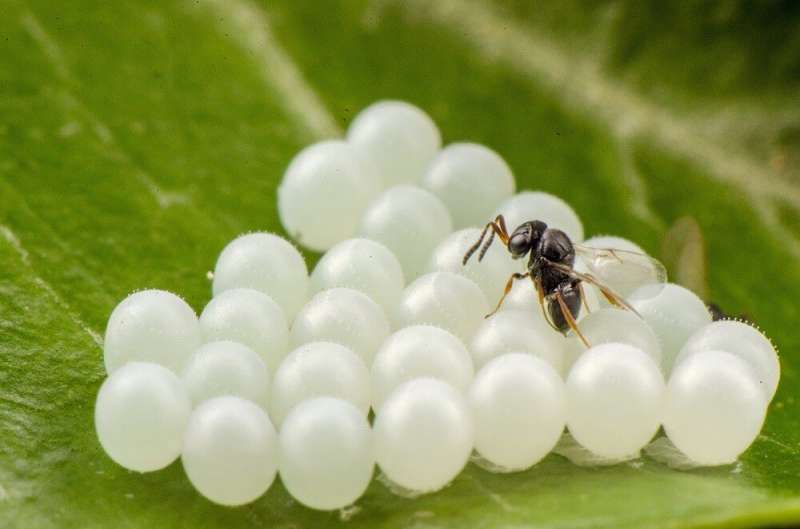Samurai wasp has minimal impact on native stink bugs, new study confirms

A new study led by CABI has confirmed that the samurai wasp (Trissolcus japonicus)—a natural enemy of the brown marmorated stink bug (Halyomorpha halys) pest—has minimal impact on native stink bugs.
Dr. Tim Haye, head of arthropod biological control, based at CABI’s center in Switzerland, teamed up with colleagues to question whether the fundamental host range of T. japonicus matches its realized host range in Europe—including Switzerland, Italy and Germany where it has already been detected.
The scientists, which included those from the University of Turin, Agriculture and Agri-Food Canada, and the Swiss Department of Finance, Economy and Agriculture, found that T. japonicus is more likely to attack species in the same ecological niche as H. halys.
The brown marmorated stink bug, originally from Asia, can cause considerable damage to fruit and nut crops in Switzerland as well as elsewhere in the world.
The Guardian newspaper in 2020 reported how scientists fear the brown marmorated stink bug has spread through eight cities in Turkey, mainly across the Black Sea region, putting around 70% of the world’s hazelnut supply at risk.
T. japonicus, which was released for the first time in a pear orchard in Zurich, Switzerland, in 2020, as part of a field trial conducted by Agroscope and supported by CABI, and is seen as a potential foe for the pest which also attacks fruit including cherries.
The latest study, which was published in the Journal of Pest Science, assessed—over three years—the realized host range of T. japonicus. It did this by exposing sentinel egg masses of H. halys and 18 non-target species and collecting naturally laid egg masses in Switzerland and Italy.
In total, 15 of 18 non-target species were successfully parasitized by T. japonicus in the field, confirming its broad fundamental host range. However, most non-target species were less parasitized by T. japonicus than H. halys, profiting from either partial temporal or spatial refuges from parasitism.
Dr. Haye said, “Species with an unusual life cycle and the same ecological niche as H. halys, such as Pentatoma rufipes, which was the most parasitized non-target species in both countries, potentially face an increased risk of parasitism.
“In contrast, beneficial non-target effects may occur for the invasive pest, Nezara viridula, which suffered high non-reproductive mortality induced by T. japonicus. In both cases, life table studies will be needed to determine the impact of non-target parasitism and the potential consequences at the population level.”
Dr. Haye and his colleagues learnt that the large majority of European stink bug species lay their eggs in spring when T. japonicus populations are low, and can therefore gain partial temporal refuge from parasitism.
In addition, species living on herbaceous hosts in the ground cover can escape intensive parasitism due to the preference of T. japonicus for woody habitats, thereby providing a spatial refuge for those species occupying such habitats.
On the other hand, species sharing the same ecological niche as H. halys (trees) are more likely to be attacked by T. japonicus, but a potential increased risk should only be considered for those species with an unusual life cycle, such as P. rufipes or Picromerus bidens (L.) (Hemiptera: Pentatomidae), that lay their eggs in late summer when the majority of parasitism by T. japonicus takes place.
Dr. Haye added, “Incorporating ecological factors such as habitat specificity, host and parasitoid phenology, host density and competition with native parasitoids or predators, can help to yield a more realistic scenario of potential risks for non-target species.”
“However, such field studies will only be possible where the biological control agents have become established—either through intentional releases or accidental establishments.”
More information:
Tim Haye et al, Does the fundamental host range of Trissolcus japonicus match its realized host range in Europe?, Journal of Pest Science (2023). DOI: 10.1007/s10340-023-01638-0
Citation:
Samurai wasp has minimal impact on native stink bugs, new study confirms (2023, June 12)
retrieved 12 June 2023
from https://phys.org/news/2023-06-samurai-wasp-minimal-impact-native.html
This document is subject to copyright. Apart from any fair dealing for the purpose of private study or research, no
part may be reproduced without the written permission. The content is provided for information purposes only.
For all the latest Science News Click Here
For the latest news and updates, follow us on Google News.

